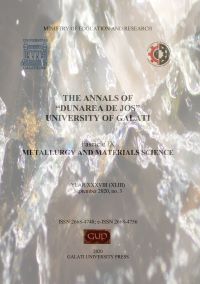The Mechanical Properties of Organic Modified Epoxy Resin
Abstract
Epoxy resins have been presenting a lot of scientific and technical interests and organic modified epoxy resins have recently receiving a great deal of attention. For obtaining the composite materials with good mechanical proprieties, a large variety of organic modification agents were used. For this study gluten and gelatin had been used as modifying agents thinking that their dispersion inside the polymer could increase the polymer biocompatibility. Equal amounts of the proteins were milled together and the obtained compound was used to form 1 to 5% weight ratios organic agents modified epoxy materials. To highlight the effect of these proteins in epoxy matrix mechanical tests as three-point bending and compression were performed.
Downloads
References
[2]. Shen Y., Cong Y., Zhang B., Lang Q., Influence on properties of epoxy nanocomposites with nanoparticles modified by surfactants with different molecular structures: liquid crystal, rigid and flexible segment structures, Materials Research Express, https://doi:10.1088/2053-1591/ab38c9, 2019.
[3]. Yi L., Fei X., Kyoung-sik M., Wong C.P., Novel Curing Agent for Lead-Free Electronics: Amino Acid, Journal of Polymer Science: Part A: Polymer Chemistry, Vol. 44, 1020-1027, 2006.
[4]. Chihai R., Ungureanu C., Cojan A, Bîrsan I. G., Cîrciumaru A., Organic modified epoxy resin. Tribologic aspects, The 10th International Conference BALTTRIB'2019, https://doi.org/10.15544/balttrib.2019.03, 2019.
[5]. Xu H., Feng Z., Chen J., Zhou H., Tribological behavior of the polyamide composite coating filled with different fillers under dry sliding, J. of Applied Polymer Science, 104, p. 2554-2560, 2007.
[6]. Samyn P., Kalacska G., Keresztes R., Zsidai L., De Baets P., Design of a tribotester for evaluation of polymer components under static and dynamic sliding conditions, Proceedings of the Institution of Mechanical Engineers, Part J: Journal of Engineering Tribology 221 pp 661-674, 2007.
[7]. DeFrates K., Markiewicz T., Gallo P., Rack A., Weyhmiller A., Jarmusik B., Hu X., Protein Polymer-Based Nanoparticles: Fabrication and Medical Applications, International Journal of Molecular Sciences, 19(6), 1717, https://doi:10.3390/ijms19061717, 2018.
[8]. Bălan I., Bosoancă R., Căpăţină A., Graur I., Bria V., Ungureanu C., A study regarding friction behaviour of lysine and isoleucine modified epoxy matrix, IOP Conf. Series: Materials Science and Engineering 174.012023 doi:10.1088/1757-899X/174/1/012023, 2017.
[9]. Djagny K. B., Wang Z., Xu S., Gelatin: a valuable protein for food and pharmaceutical industries: review, Crit. Rev. Food Sci. Nutr. 41 (6), 481e492, 2001.
[10]. Rapisarda M., Valenti G., Carbone D. C., Rizzarelli P., Recca G., La Carta S., Fincchiaro S., Strength, fracture and compression properties of gelatins by a new 3D printed tool, Journal of Food Engineering, 220, p. 38-48, https://doi:10.1016/j.jfoodeng.2017.05.016, 2018.
[11]. Li X., Jiang G., Yang L., Peng S., Study of gelatin as biodegradable shale hydration inhibitor, Colloids and Surfaces A: Physicochemical and Engineering Aspects, 539, p. 192-200, https://doi:10.1016/j.colsurfa.2017.12.020, 2018.
[12]. Fabra M. J., Lopez-Rubio A., Lagaron J. M., Effect of the film-processing conditions, relative humidity and ageing on wheat gluten films coated with electrospun polyhydryalkanoate, Food Hydrocolloids, 44, p. 292-299, 2015.
[13]. Tom Keenan, Gelatin, Polymer Science: A Comprehensive Reference Volume 10, Pages 237-247, 2012.
[14]. Ciapponi R., Turri S., Levi M., Mechanical Reinforcement by Microalgal Biofiller in Novel Thermoplastic Biocompounds from Plasticized Gluten, Materials, 12(9), 1476. doi:10.3390/ma12091476, 2019.
[15]. Jin F.-L., Li X., Park S.-J., Synthesis and application of epoxy resins: A review, Journal of Industrial and Engineering Chemistry, 29, p. 1-11, doi:10.1016/j.jiec.2015.03.026, 2015.
[16]. Vo Hong N., Van Puyvelde P., Van Vuure A., Verpoest I., Preparation of biocomposites based on gluten resin and unidirectional flax fibers, Conference: ECCM15 - 15th European Conference on Composite Materials, 2012.
[17]. Gällstedt M., Mattozzi A., Johansson E., Hedenqvist M. S., Transport and tensile properties of compression-molded wheat gluten films, Biomacromolecules 5, p. 2020-2028, 2004.
[18]. ***, http://www.polydis.ro/wpcontent/uploads/2014/08/Epiphen-4020.pdf.
[19]. Bîrsan I. G., Andrei G., Ungureanu V., Roman I., Cîrciumaru A., Wear behavior of fabric reinforced epoxy based composites, Proceeding of the International Conference BALTTRIB’2009, p. 158-163, 2009.
[20]. Bîrsan I. G., Andrei G., Bria V., Postolache I., Cîrciumaru A., Tribological behavior of clay/epoxy reinforced epoxy composites, Proceeding of the International Conference BALTTRIB’2009, p. 154-169, 2009.
[21]. Bîrsan I. G., Cîrciumaru A., Bria V., Ungureanu V., Tribological and Electrical Properties of Filled Epoxy Reinforced Composites, Tribology in industry, 31, 1-2, p. 33-36, 2009.
[22]. Bart J. C. J., Additives in Polymers. Industrial Analysis and Applications, John Wiley & Sons, 2005.
[23]. Amit C., Muhammad S. I., Fabrication and characterization of TiO2–epoxy nanocomposite, Materials Science and Engineering A 487, p. 574-585, 2008.



